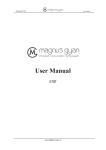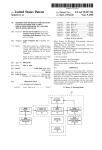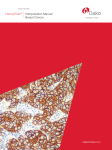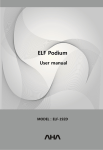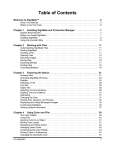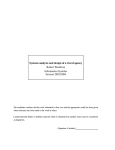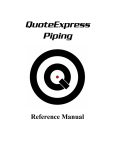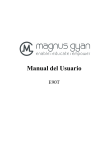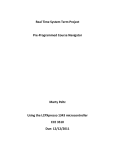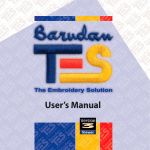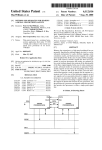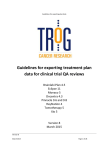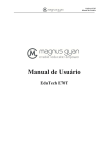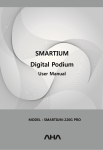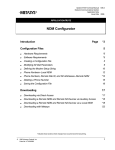Download Digitizer interface
Transcript
US006353433B1 (12) United States Patent (10) Patent N0.: Schumer (54) (76) (,1) (45) Date 0f Patent: DIGITIZER INTERFACE Inventor; Notice, US 6,353,433 B1 *Mar. 5, 2002 4,451,895 A * 5/1984 Sliwkowski .............. .. 345/156 4,578,768 A * 3/1986 Racine ...................... .. 4,677,258 A * St” Redmond, WA (Us) 98053 4,716,542 A This patent issued on a Continued pros_ 4,763,356 A 4,821,029 A * * 8/1988 Day, Jr. et a1. .. 345/173 4/1989 Logan et a1. ............. .. 345/173 4,827,410 A * 5/1989 . . . 6/1987 Kawashima et al. 178/18 A]fred L_ Schumer, 20522 NE 66th 12/1987 Peltz et al. .......... .. Corren 178/18 15/64 ..................... .. 345/179 ecunon apphcanoh ?led under 37 CFR 4,855,725 A * 8/1989 Fernandez 153911)’ and 1S shhleht to the twenty Year 4,933,514 A * 6/1990 Bowers .............. .. 178/18 Pawnt term PYOVISIOHS 0f 35 U-S-C154(a)(2)- 5,031,119 A * 5,049,862 A * 7/1991 Dulaney et a1. 9/1991 Dao et a1. 5,768,492 A 6/1998 Subject to any disclaimer, the term of this patent is extended or adjusted under 35 _ 345/173 345/179 Schumer ................... .. 345/173 OTHER PUBLICATIONS U'S'C' 154(k)) by 0 days‘ _ * 345/185 BroWn, Edward; A WindoWing Mechanism for Structuring _ _ _ Input; Oct. 3, 1985; Manuscript Thesis University of Tor Tlhls Patent 15 Sublect to a termmal dls' onto Library Department of Computer Science. c a1mer. (List continued on neXt page.) (21) Appl- NOJ 09/098,034 (22) Filed: Primary Examiner—Regina Liang Jun_ 15’ 1998 Attorney, Agent, or Firm—Graybeal Jackson Haley Related US. Application Data (60) (57) Continuation of application No. 08/634,065, ?led on Apr. A digitizer interface that translates the digitizer-speci?c 18: 1999: how Pat- NO- 577687492: which is a division of reports into virtual areas of the digitizer Which may be 3511132223 NO‘ 07/716305’ ?led on Jun‘ 17’ 1991’ now divided into speci?c regions or virtual tablets. Each region permits the speci?cation of individual coordinate systems or a a a a a a a a a a a a a a a a a a a a a a a a a a a a a a a a a a a a a a a a a a a a a a a a . (52) [15- Cl (58) 345/173 Field of Search ............................... .. 345/173, 174, mented on a host computer, in the digitizer, or in interme diate electronics. The interface allows reports from digitiz 345/178, 179, 175, 176, 177, 156; 178/18.01, 18.03—18.09, 19.01, 20.01 (56) ABSTRACT ers of differing data output formats to be translated into a standard format internal to the interface thereby isolating the host processor from a given digitizer’s attributes. The inter face may be con?gured to operate many digitizers from a References Cited single host. US. PATENT DOCUMENTS 64 Claims, 13 Drawing Sheets 4,058,849 A * 11/1977 Fitzgerald et al. IO IO - I | Region ,' ‘ Region , \ I l 1'‘ II \ Ill I: ‘|l'“"""| ‘ I II “>|____l “ \ \ I \“ ‘II "I I: ‘f'-"_J| t ‘I \____'| Tablet , I Flagron , \ l \ I \“ III ‘I I’ 1 ll \l'""J|' , 8 \____l|/ ,' I I l ‘I I US 6,353,433 B1 Page 2 OTHER PUBLICATIONS Stevenson, David; (1990) “Absolute Pointing Device Memory Structure” Macintosh Technical Notes #266. Sample ‘ADBS’ Resource; (1989) Apple Macintosh Devel oper Technical Support; Apple Computer Inc. WIZ User’s Guide PC Edition. Johnson, Timothy E.; (1990) “Closer to that pen—and—paper feel” MacWeek. Saarela, Janne; (1995) ANSI GKS Standard LCS04539—LCS04561. Seiko Instruments USA Graphic Devices and Systems Divi sion; (1990) Digitizing Tablet SoftWare User’s Guide [LCS01583—LCS01617]. ADI Program Autodesk, Inc. (1996) Autodesk Device Inter face/ADI Driver Development Kit Version 2.1. ShaW, Richard Hale; (1989) Exploring the Key Functions of the OS/2 Keyboard and Mouse Subsystems Microsoft Sys tems Journal. Gilol, Wolfgang K.; (1978) “Interactive Computer Graph ics—Data Structures, Algorithms, Languages” Technical University of Berlin and University of Minnesota [LCS04976—05011]. User manual Hitachi SoftWare Utilities Version 1.01; (1988) Hitachi America, Ltd. The Microsoft Universal Pointing Device interface, Appli cation Note, Revision 1.1 (1985) Microsoft Corporation. Microsoft Mouse Driver SoftWare Interface manual [LCS07104—07124]. Tablet Extensions to the Mouse Driver Standard (1989) LCS/Telegraphics [LCS06491—06506]. ming Reference; Publication 84—0850—202. XMOUSE Programming Reference (1988) LCS/Telegraph ics [LCS06338—06405]. IS Pensmith Drivers for DOS & WindoWs (1990) Kurta MM 1201 and MM 961 Data Tablets Technical Refer Summagraphics Corporation (1990) Tablet.com Program Corporation. ence(1984) Summagraphics Corporation LCS01352—01431. BroWn, E. et al.; (1985) “WindoWs on Tablets as a Means of SummaSketch Drivers/Utilities User’s Guide(1988) Sum Achieving Virtual Input Devices” Computer Systems magraphics Corporation. Research Institute LCS05114—LCS05119. SummaSketch User’s Guide (1985) \Summagraphics Cor Buxton, William, et al.; (1986) “A Study in TWo Handed Input” Computer Systems Research Institute [LCS05108—05113], pp. 1—10. Device Driver Adaptation Guide; (1990) Microsoft Win poration. doWs Device Development Kit Version 3.0 for the MS—DOS or PC—DOS Operating System. IBM Operating System/2 Programming Tools and Informa tion Version 1.2 (1989) [LCS07419—07479]. MM II 1812 Graphics Tablet Technical Reference (1990) Summagraphics Corporation. The Autodesk Device Interface/ADI [LCS08315—08430]. ADI Driver Technical Reference LCS/Telegraphics [LCS06484—08235]. * cited by examiner U.S. Patent Mar. 5,2002 Sheet 1 0f 13 US 6,353,433 B1 2 i Single-User FIG H Network U.S. Patent Mar. 5,2002 Sheet 3 0f 13 US 6,353,433 B1 22"” f Device / '2 U.S. Patent Mar. 5,2002 Sheet 4 0f 13 —"' Status No Bit? ' Yes ‘ US 6,353,433 B1 Coordinates? Event Adjust Packet Signs Error Process Packet Coordinates I Response Process Packet Events PM}, 41 .——— U.S. Patent Mar. 5,2002 Sheet 5 0f 13 US 6,353,433 B1 @m m _ 1IoQmb. _ _ _ _ _ _ _ _ _ _ U.S. Patent Mar. 5,2002 Sheet 8 0f 13 QQ lmEBMdozw: MJvUKw U US 6,353,433 B1 U.S. Patent Mar. 5, 2002 Sheet 10 0f 13 US 6,353,433 B1 Initialize System Host Command? NO Procedure Command? No 1 l Yes v Read Host Command Read Procedure Command Process Command FIG, M) U.S. Patent Procedure I Mar. 5, 2002 Ygs Rm? No US 6,353,433 B1 Sheet 11 0f 13 No Ya Queue Packet l Enable Host 'l‘mnsmisaion PM; U U.S. Patent Mar. 5,2002 Sheet 12 0f 13 Decode D. 'I‘ablet to . . V Rapon Tablct Enabled? US 6,353,433 B1 No PM} H2 US 6,353,433 B1 1 2 DIGITIZER INTERFACE action to perform is decided Within the host computer by translating the button state and location of the cursor into knoWn areas of the video display or digitiZing tablet. If the This is a continuation of the prior application Ser. No. 08/634,065, ?led Apr. 18, 1996 now US. Pat. No. 5,768, 492, Which is a divisional of prior application Ser. No. 07/716,305, ?led Jun. 17, 1991 noW abandoned. action is based on translation of the action to a location Within the video display, it is often referred to as a “menu selection.” Alternatively, if the translation is performed based on a location Within the digitiZer, it is referred to as a BACKGROUND OF THE INVENTION 1. Field of the Invention This invention relates in general to digitizing or data 10 “template command.” This latter method often requires a “template” or physical menu positioned over the digitiZer and depicting speci?c locations as menus or graphical tablets (“digitiZers”) and in particular to interfacing digitiZ images. ers to host computers, their operating systems and applica Regardless of the method used for translating the action, considerable computing time by the host processor is required Which is often directly related to the number of tion programs. 2. Background Art DigitiZers are computer peripherals that translate a user’s hand motion into digital coordinates suitable for use by a computer system. This translation is performed Within an X, Y and possibly Z coordinate system Within the device comprising an electronic grid over Which is placed a trans ducer. This transducer may be pen-shaped (“stylus”), rect angular or elliptical (“cursor” or “puck”) containing one or more buttons. A microprocessor Within the digitiZer trans lates the position of the transducer on the grid into digital 15 20 lation Which often constrains the translation to a speci?c 25 coordinates and reports its location and button status to the host computer via a communications link Which is typically a stream of serial bits. Information transmitted to the host computer is encapsu locations Within the video display or digitiZer Which must be tested and translated. This computing time reduces the amount of computing available to the host operating system or its application programs. Furthermore, in the event the translation is based upon locations Within the digitiZer, information pertaining to the speci?c digitiZer such as its physical siZe and con?guration must be used in the trans 30 lated in a speci?c format comprising multiple characters of digitiZer and requires a different methodology for each digitiZer siZe and type. Heretofore, efforts to provide template translations have been restricted to a small number of template areas and implemented as a series of computer instructions speci?c to the digitiZer and the actual location of each menu location on the digitiZer surface. These instructions may be executed by the microprocessor Within the digitizer or by the host data Which are grouped into the button information and coordinates. Each transmission of this information is referred to as a “report.” Reports are sent either continuously 35 processor through the use of a dedicated translation appli cation program. When done this Way, these methods are or upon satisfaction of some de?ned combination of button referred to as “hard-coded” templates and are determined at states or distance moved. The rate at Which reports are sent from the digitiZer to the host computer varies considerably depending upon the particular digitiZer, the speci?cation of the button states or programmed con?guration and may range up to several hundred times per second. In addition to transmitting coordinate data to the host computer, digitiZers often accept commands from the host computer governing the operating characteristics of the digitiZer. These commands are usually encoded in individual characters Which collectively comprise a command and its arguments. Examples of such commands include scaling the 40 Without redesigning the digitiZer or recreating the applica tion program on the host processor. Hard-coded templates necessarily restrict template trans 45 user the ability to modify or even create their oWn templates. 50 are transmitted or specifying the type or format of informa tion sent With each report. Upon receipt of each character of data from the digitiZer, the host system is interrupted from the task it Was engaged in and processes the data by combining it With previous data Furthermore, such templates are restricted to the speci?c digitiZer, are often expensive to develop or purchase and require considerable host processor computing time result ing in loWer system throughput manifested by sloWer appli cation response time. 55 SUMMARY OF THE INVENTION characters until a complete report has been received. It then The principal object of the present invention is to provide a method of de?ning, manipulating and processing large translates this data and takes appropriate action depending on the information contained in the report, e.g. button presses or releases or coordinate values. Such actions may include moving a visible cursor on the video display attached to the host computer or selecting some action depending on the location and status of one or more buttons. lation activities to the time of digitiZer manufacture or creation of the application program by experienced com puter professionals and do not afford the typical computer digitiZers axis to an absolute value or resolution in counts per unit of measurement, selecting the rate at Which reports the time of digitiZer manufacture or creation of the appli cation program or template. Once created, these instructions are dependent upon the knoWn digitiZer attributes and the locations to be translated. Hence, they cannot be changed numbers of template locations on a digitiZer in a manner 60 Which signi?cantly reduces host processor computation. The templates may be created and changed dynamically by computer users and application programs and the application programs are not restricted to any speci?c digitiZer or host DigitiZers are frequently used to draW information into an 65 processor. In ful?llment and implementation of the previously application program or select some application command recited object, a primary feature of the invention resides in via a button press or release. The determination of Which US 6,353,433 B1 3 4 the de?nition and methodology of an advanced digitizer embodiment implemented as discrete microprocessor circuit, the ?rmWare instructions to the preferred embodi ment and ?nally an eXample of using the Interface Within an application conteXt. The Interface details the conceptual methodology and speci?c command structure While the circuit description discloses one possible implementation for an IBM PC/AT personal computer. The ?rmWare description interface (the “Interface”) Which allows the dynamic cre ation and manipulation of template areas non-speci?c to any digitizer or host processor. Embedded in this Interface is a de?ned methodology for translating digitiZer-speci?c reports into virtual areas of the digitiZer Which are accessed as speci?c numbered regions. Each of these regions may possess various attributes Which collectively permit the includes block ?oWcharts of computer instructions for com bining the Interface and microprocessor circuit and the application eXample demonstrates their use in creating a speci?cation of individual coordinate systems or stored sequences of commands. template menuing system. An additional feature of the invention includes a device Interface Description independent Interface to the digitiZer Which isolates the computer user or application program from a given digitiZ er’s attributes and permits creation of one set of instructions Which may be eXecuted across any number of digitiZers or host processor systems. The invention includes a tablet addressing feature Which alloWs many tablets to be con Con?guration 15 of the Interface is the ability to execute Interface commands Without modi?cation across either con?guration through the use of tablet addresses (see Packet Protocol beloW). The single-user con?guration 2 of the Interface may be nected to a single computer or a netWork of computers and operated independently of each other. Finally, the preferred embodiment of the invention uti liZes a dedicated microprocessor to implement this advanced digitiZer Interface Which signi?cantly improves host proces sor throughput and application response time (the “Circuit”). implemented as a discrete microprocessor circuit as 25 an EIA-232 serial communications link. The netWork con?guration 4 of the Interface may be implemented across a number of Well-known, industry standard netWork topologies and architectures. HoWever, the preferred embodiment utiliZes the nine-bit serial communi cations mode inherent in the microprocessor of the circuit performance considerations. BRIEF DESCRIPTION OF THE DRAWINGS (as described beloW) utiliZing the topology and architecture of the BITBUS Interconnect Serial Control Bus across an 35 Interconnect Serial Control Bus Speci?cation” (Intel Corporation, 1988). The EIA-485 serial communications FIG. 3. illustrates the relationships among the three coor standard is fully described in “Standard for Electrical Char acteristics of Generators and Receivers for Use in Balanced dinate systems embodied in the present invention; FIG. 4. is a ?oWchart depicting a packet decoding pro Digital Multipoint Systems” (Electronics Industry Association, 1983). Logical Layers cess; 45 the present invention. FIG. 8. is a schematic of the Programmed Input/Output circuit for the present invention. 55 The tablet layer 8 provides the ?rst true level of abstrac of the present invention; tion to an application program and is consistent across all FIG. 12. is a ?oWchart depicting interrupt event process devices. It is the logical level at Which device-independent ing of the present invention; FIG. 13. illustrates an eXample template menuing system created With present invention; tions including: a description of the Interface, the preferred formats and physical characteristics into a device independent format internal to the Interface. The device layer may be queried for certain attributes but cannot be changed. FIG. 11. is a ?oWchart depicting command eXecution unit DESCRIPTION OF THE INVENTION The description of the invention encompasses four sec Referring to FIG. 2, the Interface supports three logical layers Which provide an increasing level of abstraction from the actual digitiZer: device 6, tablet 8 and region 10. The device layer 6 represents the physical device or digitiZer Whose properties are established at the time of manufacture. Since digitiZers vary greatly both in terms of physical characteristics and output formats, the device layer provides the ?rst level of abstraction by translating both the FIG. 9. is a schematic of the Bus Interface Unit circuit for the present invention. FIG. 10. is a ?oWchart depicting the main program loop of the present invention; EIA-485 serial communications link. This serial bus stan dard is Well-known and fully described in “The BITBUS digitiZer layers embodied in the present invention; FIG. 5. is a block schematic of four circuits for the present invention. FIG. 6. is a schematic of the Central Processing Unit circuit for the present invention. FIG. 7. is a schematic of the Serial Input/Output circuit for described beloW (see “Circuit”) or Within the microproces sor of the digitiZer connected directly to a host processor via This microprocessor may be implemented as either an input-output processor for the host system, dedicated exter nal controller or a replacement to the digitiZer microproces sor itself; the choice of Which is governed by cost and FIG. 1 illustrates the single-user and netWork con?gura tions embodied in the present invention; FIG. 2 illustrates the relationships among the conceptual Referring to FIG. 1, the Interface supports tWo con?gu rations: single-user 2 and netWork 4. The single-user 2 con?guration supports one digitiZer per system While the netWork con?guration 4 supports up to siXteen digitiZers inter-connected to a single host system. An important feature control over the Interface is eXercised and incorporates a device-independent coordinate system Which may be scaled by an application program and Within Which regions are 65 created. The region layer 10 provides the highest level of abstrac tion to the application program and from Which all user US 6,353,433 B1 5 6 events are generated. The region layer consists of discrete areas de?ned Within the tablet layer Which may be assigned speci?c attributes such as event masks, de?nable coordinate signi?cant-bit of each Word. This phase bit is a logical-one packet Word. This alloWs both the Interface and host pro systems or stored sequences of Interface commands cessor to detect the start of each packet from a stream of data executed upon some user-event. as Well as the recognition of invalid packets. at the start of each packet and Zero for each successive The siZe and format of each packet depends on the packet type of Which the preferred embodiment of the Interface supports three: command, response and event packets. Com Coordinate Systems A “coordinate system” is used to identify a point relative to a horiZontal, vertical and occasional Z-axis. All coordi nate systems have an origin and may be transformed, scaled mand packets are transmitted from the host processor to the Interface and contain both commands and arguments. Upon or rotated. Each point on a tablet can be located by means execution of the command, the Interface sends a response packet back to the host processor containing both an error of a unique pair of X and Y coordinates. Referring to FIG. 3, the Interface supports three such coordinate systems: device 12, tablet 14 and regional 16. The device coordinate system 12 is dependent upon the physical properties of each digitiZer and cannot be changed by an application program. HoWever, properties of the device coordinate system can be queried including the code and arguments, if appropriate. Finally, event packets 15 are generated by the Interface in response to user-actions such as button presses, button releases or movement of the cursor Within a speci?c region. The three layers of the Interface accept commands, gen erate responses and, in the case of regions, generate events based on a 15-bit addressing scheme embedded in each device axis, extents and resolution. The tablet coordinate system 14 is super-imposed on all devices that the Interface supports and is used to de?ne regional coordinate systems and upon Which all tablet geom packet. The address is alWays contained in the second Word of each packet regardless of packet type and is formatted as folloWs: |0 |T | TABLETI R | REGION Where: Tablet group bit (bit 14) indicating the address is directed to a group of tablets the number of Which is contained in the tablet address. TABLET Tablet address (bits 10-13) indicating the address of the tablet or group to Which a command or response is directed or generated. R Region group bit (bit 9) indicating the address is directed to a group of regions the number of Which is contained in the region REGION Region address (bits 0-8) indicating the address of the region or address. group to Which a command or response is directed or an event generated. etries are calculated. The tablet coordinate system extents This addressing scheme is analogous to a post of?ce box address in Which the tablet address refers to the post office may be scaled 18 either by explicitly setting the extents or implicitly by setting the resolution in lines per inch. The and the region address to the particular box. In this regard, tablet coordinate system may not be tansformed or rotated 45 commands and responses at the tablet layer require only the and cannot be changed once one or more regions have been tablet address—the region address ignored. Similarly, region de?ned. commands, responses and events require both the tablet and Regional coordinate systems 16 (also referred to as local coordinate systems) are the most poWerful and versatile region address. coordinate systems supported by the Interface and may be scaled 20, transformed 22 or rotated 24. Prior to use, they must be explicitly created by specifying the bounding rect angle in tablet coordinates and may be destroyed explicitly by closing each region or implicitly When closing the tablet. Commands addressed to the device layer are speci?ed With a tablet address, rather than device address, in order to 55 Once created, a regional coordinate system may be scaled by changing the extents or resolution, transformed by mov ing the origin or rotated by specifying a counter-clockwise rotation factor in degrees. Each of these properties may also facilitate the allocation of multiple logical tablets per physi cal device. This allocation may be performed by appropriate commands from the host processor and requires partitioning the physical device into one or more logical areas. Each area responds to commands directed to a particular tablet and be queried, generating response packets Whose format is generates event packets using tablet addresses for Which dependent on the information requested. Which they have been assigned (see Interface Description: Event Processing beloW). Packet Protocol All communication betWeen the Interface and host pro cessor is accomplished via packets Which comprise tWo or more 16-bit Words. Each packet is delineated and synchro niZed through the use of a phasing bit in the most 65 The format of a command packet issued to the Interface from the host processor is as folloWs: US 6,353,433 B1 P 0 COMMAND | 0 T TABLET| R | 0 0 0 0 0 REGION (ARGUMENT 1) (ARGUMENT 2) (ARGUMENT 3) (ARGUMENT 4) where: P Phase bit (bit 15) which is set for the ?rst packet word and clear COMMAND Numerical command identi?er (bits 7-13) corresponding to one T Tablet group (bit 15) address. TABLET Tablet address (bits 10-13) to which the command is issued. R Region group (bit 9) address. for all other words. of the Interface commands. REGION Region address (bits 0-8) to which the command is issued —— Zero ARGUMENT 1 if command addresses only the tablet. Optional argument dependent on the command speci?ed. Not present if the command does not take one or more arguments. ARGUMENT 2 Optional argument dependent on the command speci?ed. Not present if the command does not take two or more arguments. ARGUMENT 3 Optional argument dependent on the command speci?ed. Not present if the command does not take three or more arguments. ARGUMENT 4 Optional argument dependent on the command speci?ed. Not present if the command does not take four or more arguments. Command packets comprise between two and six words. Extra arguments to command packets are ignored while though this capability can be over-ridden. insuf?cient arguments result in packet rejection by the Response packets can take one of two forms—command acknowledgement or command response—depending on the Interface. Typically, a host processor device driver will format the packet correctly for an application program particular command and whether it executed successfully. Response packets aare formatted as follows: P S 0 0 0 0 0 COMMAND TABLET | R | I RESULT REGION (ARGUMENT 1) (ARGUMENT 2) (ARGUMENT 3) (ARGUMENT 4) where: P Phase bit (bit 15) which is set for the ?rst packet word and clear RESULT for all other words. Status bit (bit 14) which is set for a response packet. Numerical command identi?er (bits 7-13) corresponding to one of the Interface commands. Result code (bits 0-6) which is Zero if the command executed TABLET Tablet address (bits 10-13) to which the command is issued. S COMMAND successfully or an error code if not. R Region group (bit 9) address. REGION Region address (bits 0-8) to which the command is issued —— Zero ARGUMENT 1 if command addresses only the tablet. Optional argument dependent on the command speci?ed. Not present if the command does not return one or more arguments or an error occurred. ARGUMENT 2 Optional argument dependent on the command speci?ed. Not present if the command does not return three or more arguments or an error occurred. ARGUMENT 3 Optional argument dependent on the command speci?ed. Not present if the command does not return three or more arguments or an error occurred. US 6,353,433 B1 10 -continued ARGUMENT 4 Optional argument dependent on the command speci?ed. Not present if the command does not return four or more arguments Commands Which execute successfully and do not request information from the Interface never return their 10 dependent on Whether coordinates are present and can comprise either tWo or four Words. arguments—only the command and result codes in the ?rst Packet Decoding packet Word and the address to Which the command Was Referring to FIG. 4, one possible method of the packet decoding for a host processor is illustrated. The processing loop begins With the receipt of a packet Word Which is ?rst checked for the presence of the phasing bit in the most signi?cant bit. If it is set, the second in most-signi?cant bit is then checked to determine Whether the remaining packet directed in the second. The packet size for these packets is alWays tWo Words. Similarly, commands Which execute and result in an error 15 never return arguments regardless of the command type— only the command and non-zero result code in the ?rst packet Word and the address to Which the command Was directed in the second. The packet size for these packets is alWays tWo Words. Words constitute an event or command response packet. If the status bit is set, the packet is a command response and the error code is tested for a non-zero value. Azero error code indicates the command requested executed success Finally, commands Which request information from the fully and the arguments, if requested by command context, Interface and execute successfully return the command and zero result code in the ?rst packet Word, the address to Which Which are generated from the region layer in response to are present and may be interpreted. Otherwise, an error occurred, the arguments are not present and the command code should be examined to determine Which command did not execute. Error packets alWays return the command and error code in the ?rst packet Word, and the address of the command in the second. If the status bit is clear, the packet is an event packet Which contains the event in the remaining bits of the ?rst the command Was directed in the second and one or more 25 arguments in the successive packet Words. The packet size for these packets is dependent upon the particular command and comprise between three to six Words. The most common packets encountered are event packets some user-action such as pressing or releasing a button and packet Word, the address of the packet in the second packet moving the cursor. Event packets take tWo forms depending Word and the X and Y coordinates, if present, in the third and on Whether coordinate data has been enabled. The format for event packets is as follows: four packet Words. The Coordinate bit (bit 8) Will be set in the ?rst packet Word (event Word) if the coordinates are P sx|Y|0|0Rc|UP|DOWN O 0 0 O TABLET 0 REGION (x COORDINATE) (Y COORDINATE) Where: P Phase bit (bit 15) Which is set for the ?rst packet Word and clear S for all other Words. Status bit (bit 14) Which is clear for an event packet. X Y Sign bit (bit 13) for the X coordinate (if present). Sign bit (bit 12) for the Y coordinate (if present). R Coordinates (bit 9) are relative from the last valid event. C UP DOWN TABLET REGION Coordinates present (bit 8); used in conjunction With relative bit. Button(s) 1-4 Were released (bits 1, 3, 5, and 7 respectively). Button(s) 1-4 Were pressed (bits 0, 2, 4, and 6 respectively). Tablet address (bit 10-13) issuing the event. Region address (bits 0-8) issuing the event. X COORDINATE If coordinate bit set in ?rst packet Word, contains the X coordinate Where the event occurred. Y COORDINATE If coordinate bit set in ?rst packet Word, contains the Y coordinate Where the event occurred. 60 present and the Relative bit (bit 9) Will be set if the coordinates are relative to the last reported position. The Unlike response or command packets, event packets do not contain command or error codes but instead a bit mask indicating the type of events Which occurred and Whether the packet contains coordinate data. Event packets are only generated from Within regions and therefore the region address is alWays valid. The packet size for event packets is coordinate values are further modi?ed With the presence of the X and Y sign bits (bits 13 and 12) in the event Word if 65 the coordinates are negative. Decoding the coordinates of the event packet requires testing for the presence of the Coordinate bit in the event

















































